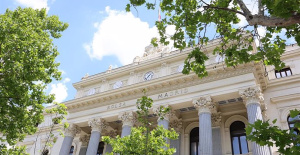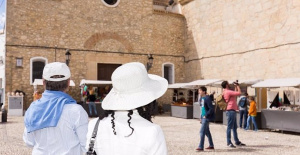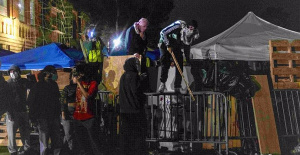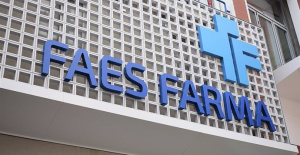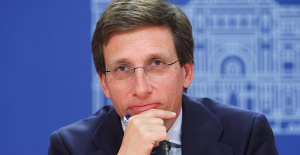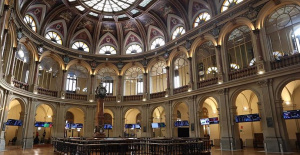MADRID, 6 May. (EUROPA PRESS) -
The Prado Museum will temporarily exhibit the work 'Ecce Homo' by the Italian painter Caravaggio thanks to a loan agreement with the Colnaghi gallery. The work will remain on display to the public from May 28 until October in an individual installation, as reported by the art gallery.
The painting, made by the great artist around 1605-09 and which was part of the private collection of Philip IV of Spain, is one of approximately only 60 known works by Caravaggio that exist, which gives it a " extraordinary value".
Since the Prado Museum alerted the Ministry of Culture in April 2021 of the relevance of the painting after its reappearance at the Ansorena auction house, when it was attributed to a student of José de Ribera, the work has been in the custody of the Colnaghi art gallery, in collaboration with Filippo Benappi (Benappi Fine Art) and Andrea Lullo (Lullo Pampoulides) and has been restored by the specialist Andrea Cipriani and his team under the supervision of experts from the Community of Madrid. The results of this process are collected in an exhaustive publication that will be available after the presentation of the work.
Since its appearance at auction three years ago, 'Ecce Homo' has represented one of the greatest discoveries in the history of art, achieving an unprecedented consensus regarding its authentication. The director of the Prado Museum, Miguel Falomir, has expressed himself in this sense, celebrating that the art gallery is the setting where "this unpublished work by CFaravaggio is shown to the public and critics." "It is a great opportunity and we must rejoice in it and, above all, celebrate that this important work will continue to stay in Spain and form part of the Spanish cultural heritage," argued Falomir.
Following a diagnostic investigation carried out by Claudio Falcucci - a nuclear engineer specialized in the application of scientific techniques to the study and conservation of cultural heritage -, the restoration has been carried out rigorously, as reported by El Prado, and each decision has been supported in an exhaustive evaluation of the work's materials and the painting's conservation history, reaffirming the initial attribution to the Italian master.
The study of the work has been carried out by Maria Cristina Terzaghi, professor of History of Modern Art at the Roma Tre University and member of the scientific committee of the Museo di Capodimonte in Naples, Gianni Papi, art historian and writer, Giuseppe Porzio, professor of History of Art at the University of Naples and Keith Christiansen (curator of the Metropolitan Museum of Art), and each of them has offered different perspectives. Specifically, the circumstances of its discovery, the provenance, the stylistic, technical and iconographic aspects of the work, its critical fortune and the master's legacy in Naples. The four experts on Caravaggio and baroque painting share the same certainty: "that Ecce Homo is a masterpiece of the Italian artist."
The oil painting represents the historical motif of the Roman governor Pontius Pilate presenting Christ to the people with the words "Ecce homo" ("Behold the man"), one of the most dramatic moments of the Passion, recorded in the Gospel of John (19 :5). The work is an example of Caravaggio's mastery of the conception process: a skillful composition that presents a completely innovative three-dimensional and dynamic scene within the limits of a deep-rooted iconographic tradition.
The presentation of Ecce Homo and the announcement of its loan - in an act of generosity on the part of its new owner - also entailed the publication of a publication that brings together leading experts in the field with seminal essays by Christiansen, Papi, Porzio and Terzaghi, testimony of the monumental importance of the work. Under the title 'Caravaggio: The Ecce Homo Revealed', the publication offers an essential starting point to understand this new addition to the catalog of works by the Italian painter.
The publication includes the specialized interpretation of the painting carried out by Maria Cristina Terzaghi (professor of History of Modern Art at the Roma Tre University and member of the scientific committee of the Museo di Capodimonte in Naples), Gianni Papi (art historian and writer ), Giuseppe Porzio (professor of Art History at the University of Naples) and Keith Christiansen (curator at the Metropolitan Museum of Art), each of whom analyze different aspects.
Specifically: the circumstances of its discovery, the provenance, the stylistic, technical and iconographic aspects of the work, its critical fortune and the legacy left by the master in Naples. Four of the most authoritative experts on Caravaggio and Baroque painting share the same passionate certainty: that Ecce Homo is a masterpiece by the Italian artist.

 Exploring Cardano: Inner Workings and Advantages of this Cryptocurrency
Exploring Cardano: Inner Workings and Advantages of this Cryptocurrency Seville.- Economy.- Innova.- STSA inaugurates its new painting and sealing hangar in San Pablo, for 18 million
Seville.- Economy.- Innova.- STSA inaugurates its new painting and sealing hangar in San Pablo, for 18 million Innova.- More than 300 volunteers join the Andalucía Compromiso Digital network in one month to facilitate access to ICT
Innova.- More than 300 volunteers join the Andalucía Compromiso Digital network in one month to facilitate access to ICT Innova.-AMP.- Ayesa acquires 51% of Sadiel, which will create new technological engineering products and expand markets
Innova.-AMP.- Ayesa acquires 51% of Sadiel, which will create new technological engineering products and expand markets A ball of light crosses Spain and Portugal
A ball of light crosses Spain and Portugal Prime Minister Fico is stabilized within gravity
Prime Minister Fico is stabilized within gravity Israel's Minister for the Diaspora considers Sánchez "responsible" for there being "more victims" in Gaza
Israel's Minister for the Diaspora considers Sánchez "responsible" for there being "more victims" in Gaza Barça strikes down Real to lift the Queen's Cup
Barça strikes down Real to lift the Queen's Cup How Blockchain in being used to shape the future
How Blockchain in being used to shape the future Not just BTC and ETH: Here Are Some More Interesting Coins Worth Focusing on
Not just BTC and ETH: Here Are Some More Interesting Coins Worth Focusing on The UA participates in the proposed Ramses mission to study the close passage of an asteroid to Earth
The UA participates in the proposed Ramses mission to study the close passage of an asteroid to Earth They develop a tool to end discrimination biases in AI
They develop a tool to end discrimination biases in AI A research group from the UA works on the development of healthy foods through AI
A research group from the UA works on the development of healthy foods through AI The Valencian researcher José Rafael Penadés, named 'fellow' of the British Royal Society
The Valencian researcher José Rafael Penadés, named 'fellow' of the British Royal Society A million people demonstrate in France against Macron's pension reform
A million people demonstrate in France against Macron's pension reform Russia launches several missiles against "critical infrastructure" in the city of Zaporizhia
Russia launches several missiles against "critical infrastructure" in the city of Zaporizhia A "procession" remembers the dead of the Calabria shipwreck as bodies continue to wash up on the shore
A "procession" remembers the dead of the Calabria shipwreck as bodies continue to wash up on the shore Prison sentences handed down for three prominent Hong Kong pro-democracy activists
Prison sentences handed down for three prominent Hong Kong pro-democracy activists ETH continues to leave trading platforms, Ethereum balance on exchanges lowest in 3 years
ETH continues to leave trading platforms, Ethereum balance on exchanges lowest in 3 years Investors invest $450 million in Consensys, Ethereum incubator now valued at $7 billion
Investors invest $450 million in Consensys, Ethereum incubator now valued at $7 billion Alchemy Integrates Ethereum L2 Product Starknet to Enhance Web3 Scalability at a Price 100x Lower Than L1 Fees
Alchemy Integrates Ethereum L2 Product Starknet to Enhance Web3 Scalability at a Price 100x Lower Than L1 Fees Mining Report: Bitcoin's Electricity Consumption Declines by 25% in Q1 2022
Mining Report: Bitcoin's Electricity Consumption Declines by 25% in Q1 2022 Oil-to-Bitcoin Mining Firm Crusoe Energy Systems Raised $505 Million
Oil-to-Bitcoin Mining Firm Crusoe Energy Systems Raised $505 Million Microbt reveals the latest Bitcoin mining rigs -- Machines produce up to 126 TH/s with custom 5nm chip design
Microbt reveals the latest Bitcoin mining rigs -- Machines produce up to 126 TH/s with custom 5nm chip design Bitcoin's Mining Difficulty Hits a Lifetime High, With More Than 90% of BTC Supply Issued
Bitcoin's Mining Difficulty Hits a Lifetime High, With More Than 90% of BTC Supply Issued The Biggest Movers are Near, EOS, and RUNE during Friday's Selloff
The Biggest Movers are Near, EOS, and RUNE during Friday's Selloff Global Markets Spooked by a Hawkish Fed and Covid, Stocks and Crypto Gain After Musk Buys Twitter
Global Markets Spooked by a Hawkish Fed and Covid, Stocks and Crypto Gain After Musk Buys Twitter Bitso to offset carbon emissions from the Trading Platform's ERC20, ETH, and BTC Transactions
Bitso to offset carbon emissions from the Trading Platform's ERC20, ETH, and BTC Transactions Draftkings Announces 2022 College Hoops NFT Selection for March Madness
Draftkings Announces 2022 College Hoops NFT Selection for March Madness











